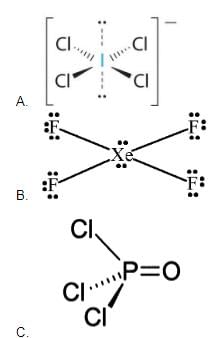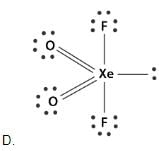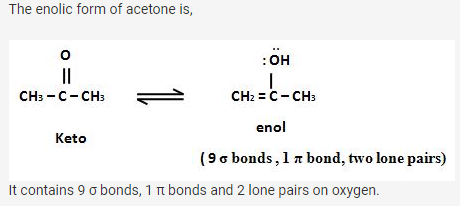All Exams >
JAMB >
Chemistry for JAMB >
All Questions
All questions of Chemical Bonding for JAMB Exam
Hybridisation of Acetylene is- a)sp
- b)sp2
- c)sp3
- d)dsp2
Correct answer is option 'A'. Can you explain this answer?
Hybridisation of Acetylene is
a)
sp
b)
sp2
c)
sp3
d)
dsp2
|
|
Riya Banerjee answered |
Since acetylene is made up of triple bond. So the hybridization of carbon in acetylene is sp.
In allene (C3H4), the type(s) of hybridisation of the carbon atoms is (are)
- a)sp and sp3
- b)sp and sp2
- c)Only sp2
- d)sp2 and sp3
Correct answer is option 'B'. Can you explain this answer?
In allene (C3H4), the type(s) of hybridisation of the carbon atoms is (are)
a)
sp and sp3
b)
sp and sp2
c)
Only sp2
d)
sp2 and sp3
|
|
Anjana Sharma answered |
The type(s) of hybridization of the carbon atoms in Allene (C3H4) is sp and sp2.
Which of the following is/are correct statement(s)?a)s + py→ two sp-hybrid orbitals lying in the yz planeb)s + px → two sp-hybrid orbitals lying in xz planec)(s + px + pz) → three sp2-hybrid orbitals lying in xz planed)(s + py) → two sp-hybrid orbitals lying along y-axisCorrect answer is option 'C,D'. Can you explain this answer?
|
|
Geetika Shah answered |
Incorrect (b)

two sp-hybrid orbitals are along x-axis.

two sp-hybrid orbitals are along x-axis.
Direction (Q. Nos. 1-11) This section contains 11 multiple choice questions. Each question has four choices (a), (b), (c) and (d), out of which ONLY ONE option is correct.
Q. Assuming that Hund's rule is violated, the bond order and magnetic nature of the diatomic molecule B2 is
- a)1 and diamagnetic
- b)0 and diamagnetic
- c)1 and paramagnetic
- d)0 and paramagnetic
Correct answer is option 'A'. Can you explain this answer?
Direction (Q. Nos. 1-11) This section contains 11 multiple choice questions. Each question has four choices (a), (b), (c) and (d), out of which ONLY ONE option is correct.
Q. Assuming that Hund's rule is violated, the bond order and magnetic nature of the diatomic molecule B2 is
a)
1 and diamagnetic
b)
0 and diamagnetic
c)
1 and paramagnetic
d)
0 and paramagnetic
|
|
Anjana Sharma answered |
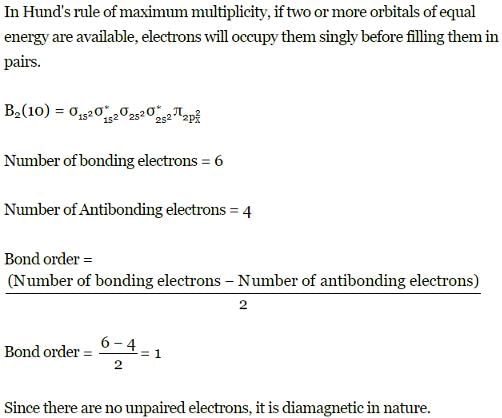
A pi-bond is formed by the overlap of:- a)p-p orbitals in sidewise manner
- b)s-p orbitals
- c)s-s orbitals
- d)p-p orbitals in end to end fashion
Correct answer is option 'A'. Can you explain this answer?
A pi-bond is formed by the overlap of:
a)
p-p orbitals in sidewise manner
b)
s-p orbitals
c)
s-s orbitals
d)
p-p orbitals in end to end fashion
|
|
Raghav Bansal answered |
pi-bond is always formed by sidewise overlapping of p – p orbitals in sidewise manner.
The correct order of increasing bond length of
I. C— H
II. C— O
III. C— C

- a)I< II< III< IV
- b)I< IV < II< III
- c)Ill < IV < II < l
- d)II < I < III < IV
Correct answer is 'B'. Can you explain this answer?
The correct order of increasing bond length of
I. C— H
II. C— O
III. C— C

I. C— H
II. C— O
III. C— C
a)
I< II< III< IV
b)
I< IV < II< III
c)
Ill < IV < II < l
d)
II < I < III < IV

|
Amrita Sen answered |
H is smallest in size thus, (C— H)bond length is least.


Hence, bonding pair in (C— O) is nearer to nucleus decreasing bond length as compared to (C— C).
Thus, I < IV < II < III.
Hence, bonding pair in (C— O) is nearer to nucleus decreasing bond length as compared to (C— C).
Thus, I < IV < II < III.
Valence Bond Theory was developed in the year- a)1916
- b)1927
- c)1930
- d)1932
Correct answer is option 'B'. Can you explain this answer?
Valence Bond Theory was developed in the year
a)
1916
b)
1927
c)
1930
d)
1932
|
|
Krishna Iyer answered |
The valence bond (VB) theory of bonding was mainly developed by Walter Heitler and Fritz London in 1927, and later modified by Linus Pauling to take bond direction into account. The VB approach concentrates on forming bonds in localized orbitals between pairs of atoms, and hence retains the simple idea of Lewis structures and electron pairs.
Expansion of octet can not take place in- a)N
- b)S
- c)Si
- d)P
Correct answer is option 'A'. Can you explain this answer?
Expansion of octet can not take place in
a)
N
b)
S
c)
Si
d)
P

|
Harshad Nair answered |
N(7) = 1s22s22p3
Nitrogen does not have (2d) orbitals. Thus, (more than 8) electrons cannot be accomodated in second orbit.
Nitrogen does not have (2d) orbitals. Thus, (more than 8) electrons cannot be accomodated in second orbit.
The shape of the below molecule is
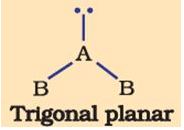
- a)trigonal
- b)rigonal planar
- c)see saw
- d)bent
Correct answer is option 'D'. Can you explain this answer?
The shape of the below molecule is

a)
trigonal
b)
rigonal planar
c)
see saw
d)
bent
|
|
Lavanya Menon answered |
The order of Repulsion: lone pair-lone pair > lone pair-bond pair > bond pair-bond pair
Due to the extra lone pair electron, the shape becomes bent.
Select the correct statement about valence bond approach.- a)Each bond is formed by maximum overlap for its maximum stability
- b)It represents localised electron model of bonding
- c)Most of the electrons retain the same orbital locations as in separated atoms
- d)All of the above are correct statements
Correct answer is 'D'. Can you explain this answer?
Select the correct statement about valence bond approach.
a)
Each bond is formed by maximum overlap for its maximum stability
b)
It represents localised electron model of bonding
c)
Most of the electrons retain the same orbital locations as in separated atoms
d)
All of the above are correct statements
|
|
Krishna Iyer answered |
(a) Hs maximum overlap - correct.

(c) Based on valence bond approach,-no prediction of change of structure due to (Ip-Ip), (Ip-bp) repulsions- correct.
(c) Based on valence bond approach,-no prediction of change of structure due to (Ip-Ip), (Ip-bp) repulsions- correct.
Which of the following angle corresponds to sp2 hybridisation?a)120∘b)180∘c)90∘d)109∘Correct answer is option 'A'. Can you explain this answer?
|
|
Samridhi Pillai answered |
sp2 hybridisation gives three sp2 hybrid orbitals which are planar triangular forming an angle of 120° with each other.
The electronic configurations of three elements A, B and C are given below.
Answer the questions from 14 to 17 on the basis of these configurations.
A ls22s22p6
B ls22s22p63s23p3
C ls22s22p63s23p
The electronic configurations of three elements A, B and C are given below.
Answer the questions from 14 to 17 on the basis of these configurations.
A ls22s22p6
B ls22s22p63s23p3
C ls22s22p63s23p
Pick out the pair of species having identical shapes for both the molecules.- a)BF3 , PCl3
- b)PF , IF5
- c)CF4,SF4
- d)XeF2 , CO2
Correct answer is 'D'. Can you explain this answer?
Pick out the pair of species having identical shapes for both the molecules.
a)
BF3 , PCl3
b)
PF , IF5
c)
CF4,SF4
d)
XeF2 , CO2
|
|
Raghav Bansal answered |
Both XeF2 & CO2 have linear structures. Both are actually linear Tri-atomic molecules.
Which molecule has a trigonal pyramidal shape?- a)AB4E
- b)AB2E2
- c)AB3E
- d)AB2E
Correct answer is option 'C'. Can you explain this answer?
Which molecule has a trigonal pyramidal shape?
a)
AB4E
b)
AB2E2
c)
AB3E
d)
AB2E
|
|
Geetika Shah answered |
AB3E: trigonal pyramidal (central atom + 3 outer atoms make a pyramid)
→ start with AB4 molecule (tetrahedral) and replace a B atom w/ lone pair
→ lone pair electrons push bonding electrons away
→ bond angles are now less than 109.5°
→ start with AB4 molecule (tetrahedral) and replace a B atom w/ lone pair
→ lone pair electrons push bonding electrons away
→ bond angles are now less than 109.5°
Polarity in a molecule and hence the dipole moment depends primarily on electronegativity of the constituent atoms and shape of a molecule. Which of the following has the highest dipole moment? - a)CO2
- b)HI
- c)H2O
- d)SO2
Correct answer is option 'B'. Can you explain this answer?
Polarity in a molecule and hence the dipole moment depends primarily on electronegativity of the constituent atoms and shape of a molecule. Which of the following has the highest dipole moment?
a)
CO2
b)
HI
c)
H2O
d)
SO2
|
|
Isha Kulkarni answered |
H2O will have highest dipole moment due to maximum difference in electronegativity of H and O atoms.


In which of the following cases, covalent bonds are cleaved?- a)Boiling of H2O
- b)Melting of KCN
- c)Boiling of CF4
- d)Melting of SiO2
Correct answer is option 'D'. Can you explain this answer?
In which of the following cases, covalent bonds are cleaved?
a)
Boiling of H2O
b)
Melting of KCN
c)
Boiling of CF4
d)
Melting of SiO2
|
|
Pooja Mehta answered |
SiO2 is a network covalent compound that has an extremely high melting and boiling point, because many silicon-oxygen bonds have to be broken in order for it to achieve the necessary freedom. To clarify, SiO2, which has a tetrahedral network lattice formation, shows that each silicon is actually bonded to 4 oxygens; each oxygen is bonded to 2 silicon. These are excess bonds aside from the ones of SiO2 which are broken.
bond lengths are lower in elements havinga)crystal structureb)double bondc)triple bondd)single bondCorrect answer is option 'C'. Can you explain this answer?
|
|
Rajesh Gupta answered |
Single bond has higher bond length than multiple bond.
Polarity in a molecule and hence the dipole moment depends primarily on electronegativity of the constituent atoms and shape of a molecule. Which of the following has the highest dipole moment? a)CO2b)HIc)H2Od)SO2Correct answer is 'C'. Can you explain this answer?
|
|
Anjana Sharma answered |
H2O will have highest dipole moment due to maximum difference in electronegativity of H and O atoms.


Q. Which of the following species contain at least one atom that violates the octet rule?a)O— Cl—-Ob)F— Xe— Fc)PCI5d)SF6Correct answer is option 'A,B,C,D'. Can you explain this answer?

|
Knowledge Hub answered |
(a) Octet of Cl expanded to (9).
(b) Octet Xe expanded to (10).
(c) Octet of P expanded to (10).
(b) Octet Xe expanded to (10).
(c) Octet of P expanded to (10).
Which is the correct order of the bond angle?- a)NH3 < NF3
- b)H2O > Cl2O
- c)PH3 < SbH3
- d)H2Te < H2S
Correct answer is option 'D'. Can you explain this answer?
Which is the correct order of the bond angle?
a)
NH3 < NF3
b)
H2O > Cl2O
c)
PH3 < SbH3
d)
H2Te < H2S

|
Nitin Patel answered |
The high electronegativity of F pulls the bonding electrons farther away from N than in NH3. Thus, repulsion between bond pairs is iess in NF3 than in NH3. Flence, the lone pair in N causes a greater distortion than NH3.
(b) as in (a)
Going down the group in periodic table, as size of central atom increases, repulsion increases.
Select the correct statement(s) about IF7.- a)I atom is sp3d3-hybridised
- b)I atom is in highest oxidation state
- c)There are five I—F longest and two I—F shortest bonds
- d)It has pentagonal bipyramidal structure
Correct answer is option 'A,B,C,D'. Can you explain this answer?
Select the correct statement(s) about IF7.
a)
I atom is sp3d3-hybridised
b)
I atom is in highest oxidation state
c)
There are five I—F longest and two I—F shortest bonds
d)
It has pentagonal bipyramidal structure
|
|
Rohit Shah answered |
Iodine heptafluoride, also known as iodine(VII) fluoride or iodine fluoride, is an interhalogen compound with the chemical formula IF7.[2][3] It has an unusual pentagonal bipyramidal structure, as predicted by VSEPR theory.[4] The molecule can undergo a pseudorotational rearrangement called the Bartell mechanism, which is like the Berry mechanism but for a heptacoordinated system.[5] It forms colourless crystals, which melt at 4.5 degC: the liquid range is extremely narrow, with the boiling point at 4.77 degC. The dense vapor has a mouldy, acrid odour. The molecule has D5h symmetry. In IF7 out of 7 Flourine atoms 5 of them are placed on a plane in Pentagon shape .In remaining 2 flourines one is placed above the plane and other below the plane each at 90 degrees
Which of the following molecule doesn’t have a lone pair?- a)BeCl2
- b)XeF4
- c)NH3
- d)H2O
Correct answer is option 'A'. Can you explain this answer?
Which of the following molecule doesn’t have a lone pair?
a)
BeCl2
b)
XeF4
c)
NH3
d)
H2O
|
|
Raghav Bansal answered |
BeCl2 has no lone pairs on the beryllium. Thus, the electrons on the chlorides willtry to stay far apart from each other, since their corresponding electrons repel each other (while experiencing no deflection from electrons on a central atom). Thus themolecule is linear in shape.
Direction (Q. Nos. 13-16) This section contains 4 multiple choice questions. Each question has four choices (a), (b), (c) and (d), out of which ONE or MORE THANT ONE is correct.
Q.
In which of the following I is more volatile than II?
- a)
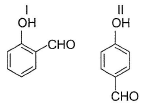
- b)

- c)

- d)

Correct answer is option 'A,B'. Can you explain this answer?
Direction (Q. Nos. 13-16) This section contains 4 multiple choice questions. Each question has four choices (a), (b), (c) and (d), out of which ONE or MORE THANT ONE is correct.
Q.
In which of the following I is more volatile than II?
In which of the following I is more volatile than II?
a)
b)
c)
d)
|
|
Hansa Sharma answered |
I. Intermolecular H-bonding makes boiling point higher than that of I. Thus, I is more volatile
II. Ortho nitrophenol is more volatile than para nitrophenol because O-Nitrophenol has intramolecular hydrogen bonding whereas para nitrophenol has inter molecular H bonding and so boils relatively at higher temperature
(c) BP of H2O > > H2S
(d) BP of CH3CH2OH (due to H-bonding) > > CH3— O — CH3
A qualitative measure of the stability of an ionic compound is provided- a)ionization enthalpy
- b)lattice enthalpy
- c)Electron affinity
- d)electron gain enthalpy
Correct answer is option 'B'. Can you explain this answer?
A qualitative measure of the stability of an ionic compound is provided
a)
ionization enthalpy
b)
lattice enthalpy
c)
Electron affinity
d)
electron gain enthalpy

|
Sounak Chaudhary answered |
stability of ionic bond is directly propotional to lattice energy.
Hydrogen bonds are formed in many compounds e.g., H2O, HF, NH3 . The boiling point of such compounds depends to a large extent on the strength of hydrogen bond and the number of hydrogen bonds. The correct decreasing order of the boiling points of above compounds is :
- a)HF > H2O > NH3
- b)H2O > HF > NH3
- c)NH3 > HF > H2O
- d)NH3 > H2O > HF
Correct answer is option 'B'. Can you explain this answer?
Hydrogen bonds are formed in many compounds e.g., H2O, HF, NH3 . The boiling point of such compounds depends to a large extent on the strength of hydrogen bond and the number of hydrogen bonds. The correct decreasing order of the boiling points of above compounds is :
a)
HF > H2O > NH3
b)
H2O > HF > NH3
c)
NH3 > HF > H2O
d)
NH3 > H2O > HF
|
|
Neha Joshi answered |
H2O>HF>NH3
Strength of hydrogen bonding depends on the size and electronegativity of the atom.
Smaller the size of the atom, greater is the electronegativity and hence stronger is the H−bonding. Thus, the order of strength of H-bonding is H...F>H...O>H...N.
But each HF molecule is linked only to two other HF molecules while each H2O molecule is linked to four other H2O molecules through H−bonding.
Hence, the decreasing order of boiling points is H2O>HF>NH3.
Which of the following is nonpolar?- a)CI3CCH3
- b)PCI5
- c)CH2CI2
- d)NH3
Correct answer is option 'B'. Can you explain this answer?
Which of the following is nonpolar?
a)
CI3CCH3
b)
PCI5
c)
CH2CI2
d)
NH3
|
|
Hansa Sharma answered |
(b) PCI5 triangular bipyramidal, symmetrical, no lone pair.
The common features among the species CN–, CO ad NO+ are- a) Bond order three and isoelectronic
- b) Bond order three and weak field ligands
- c) Bond order two and acceptors
- d) Isoelectronic and weak field ligands
Correct answer is option 'A'. Can you explain this answer?
The common features among the species CN–, CO ad NO+ are
a)
Bond order three and isoelectronic
b)
Bond order three and weak field ligands
c)
Bond order two and acceptors
d)
Isoelectronic and weak field ligands
|
|
Nandini Patel answered |
According to M.O theory,
CN−,CO and NO+ are isoelectronic (14e−) and bond order is 3.
a is the correct answer.
Consider the two structures :

Select the correct statement(s).
a)I is bent, II is linearb)I is linear, II is bentc)Both is bentd)Both are linearCorrect answer is option 'B'. Can you explain this answer?
|
|
Geetika Shah answered |
1 has three lone pair and two bond pair, its representation will be AB2L3 and according to VSEPR theory it is linear in shape.
2 has two LP and two BP which representation will be AB2L2, so according to VSEPR theory it will be bent or it can also said to be 'V' shaped.
Hence B is correct.
Rank the following bonds in order of increasing polarity: H-N, H-O, H-C.- a)H-O < H-N < H-C
- b)H - C < H-N < H-O.
- c)H - C < H-O < H-N.
- d)H-N < H-O < H-C
Correct answer is option 'B'. Can you explain this answer?
Rank the following bonds in order of increasing polarity: H-N, H-O, H-C.
a)
H-O < H-N < H-C
b)
H - C < H-N < H-O.
c)
H - C < H-O < H-N.
d)
H-N < H-O < H-C

|
Rahul Chaudhary answered |
O is more electronegative than N which is more electronegative than C.
Valence bond theory was introduced by:
- a)Gillespie
- b)Heitler
- c)Pauling
- d)Lewis
Correct answer is option 'B'. Can you explain this answer?
Valence bond theory was introduced by:
a)
Gillespie
b)
Heitler
c)
Pauling
d)
Lewis
|
|
Preeti Iyer answered |
He then called up his associate Fritz London and they worked out the details of the theory over the course of the night. Later, Linus Pauling used the pair bonding ideas of Lewis together with Heitler–London theory to develop two other key concepts in VB theory: resonance (1928) and orbital hybridization (1930).
Which of the following will have highest value of bond enthalpy?- a)Cl-Cl bond
- b)H-H bond
- c)F-F bond
- d)Br-Br bond
Correct answer is option 'B'. Can you explain this answer?
Which of the following will have highest value of bond enthalpy?
a)
Cl-Cl bond
b)
H-H bond
c)
F-F bond
d)
Br-Br bond

|
Anshika Singh answered |
H-H bond will have higher Bond enthalpy because of small atomic structure.
In which of the following substances will hydrogen bond be strongest?- a)HCl
- b)H2O
- c)HI
- d)H2S
Correct answer is option 'B'. Can you explain this answer?
In which of the following substances will hydrogen bond be strongest?
a)
HCl
b)
H2O
c)
HI
d)
H2S
|
|
Rahul Bansal answered |
HC1, HI and H2S do not from H-bonds. Only H2O forms hydrogen bonds. One H2O molecule forms four H-bonding.

The bond between B and C will be- a)Ionic
- b)Covalent
- c)Hydrogen
- d)Coordinate
Correct answer is option 'B'. Can you explain this answer?
The bond between B and C will be
a)
Ionic
b)
Covalent
c)
Hydrogen
d)
Coordinate
|
|
Jayant Mishra answered |
Both B and C are non-metals and therefore, bond formed between them will be covalent.
In which one of the following species the central atom has the type of hybridisation which si not the same as that present in the other three? - a)SF4
- b)I3-
- c)SbCl52-
- d)PCl5
Correct answer is option 'C'. Can you explain this answer?
In which one of the following species the central atom has the type of hybridisation which si not the same as that present in the other three?
a)
SF4
b)
I3-
c)
SbCl52-
d)
PCl5
|
|
Geetika Shah answered |
Molecules having the same number of hybrid orbitals, have same hybridisation and number of hybrid oebitals.

where,

where,
V= number of valance electrons of central atom
X = number of monovalent atoms
C= charge on cation
A = charge on anion

Direction (Q. Nos. 17) Choice the correct combination of elements and column I and coloumn II are given as option (a), (b), (c) and (d), out of which ONE option is correct.Q. Match the orbital overlap figures shown in Column I with the description given in Column II and select the correct answer using the code given below the columns.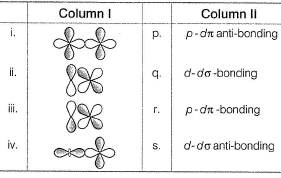
 [JEE Advanced 2014]
[JEE Advanced 2014]- a)a
- b)b
- c)c
- d)d
Correct answer is option 'C'. Can you explain this answer?
Direction (Q. Nos. 17) Choice the correct combination of elements and column I and coloumn II are given as option (a), (b), (c) and (d), out of which ONE option is correct.
Q. Match the orbital overlap figures shown in Column I with the description given in Column II and select the correct answer using the code given below the columns.
[JEE Advanced 2014]
a)
a
b)
b
c)
c
d)
d

|
Ciel Knowledge answered |
(i) (d-d) σ-bonding (ii) (p-dπ bonding)
(iii) (p-dπ anti-bonding) (iv) (ddσ anti-bonding)

(iii) (p-dπ anti-bonding) (iv) (ddσ anti-bonding)
Select the correct statement(s) about NO2.- a)It is paramagnetic in nature
- b)It forms dimer and paramagnetic is lost
- c)NO2 and dimer formed have sp2-hybridised N-atom
- d)Brown colour of NO2 fades and (N— N) bond length is greater than normal (N— N) bond length
Correct answer is option 'A,B,C,D'. Can you explain this answer?
Select the correct statement(s) about NO2.
a)
It is paramagnetic in nature
b)
It forms dimer and paramagnetic is lost
c)
NO2 and dimer formed have sp2-hybridised N-atom
d)
Brown colour of NO2 fades and (N— N) bond length is greater than normal (N— N) bond length
|
|
Pooja Shah answered |
Due to unpaired electron paramagnetic, N-atom in NO2 is electron deficie nt thus, to complete octet, dimer is formed.
In N2O4 formation, each N-atom gets
Thus, (a), (b), (c) and (d) are correct.
Mean bond enthalpy of different bonds are given
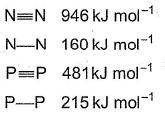 Out of the given pairs, which compound is more stable than the other?
Out of the given pairs, which compound is more stable than the other?
- a)

- b)

- c)

- d)None of these
Correct answer is option 'A'. Can you explain this answer?
Mean bond enthalpy of different bonds are given
Out of the given pairs, which compound is more stable than the other?
a)
b)
c)
d)
None of these

|
Knowledge Hub answered |
Bond enthalpy of six (P— P) bond = 6 x 215 = 1290 k j mol-1
Bond enthalpy of six (N — N) bond = 6 x 160
= 960 kJ mol-1
Thus, P4 is more stable than N4.
Hybridization of C2and C3of H3C −− CH = C = CH −− CH3are - a)Sp, Sp3
- b)Sp2, Sp2
- c)Sp2, Sp
- d)None of the above
Correct answer is option 'C'. Can you explain this answer?
Hybridization of C2and C3of H3C −− CH = C = CH −− CH3are
a)
Sp, Sp3
b)
Sp2, Sp2
c)
Sp2, Sp
d)
None of the above
|
|
Arun Khanna answered |
The first carbon atom forms four sigma bonds, three with Hydrogen and one with carbon. So, the carbon here is sp3 hybridised.The second carbon atom forms three sigma bonds and one pi bond. The three sigma bonds can be possible only when carbon is sp2 hybridised. The fourth electron forms a pi overlap with an electron from third carbon atom.
Carbon atom 3 forms two sigma bonds and is sp hybridised. The two p electrons form a pi bond with p electrons of the neighbouring carbon atoms.Carbon atom 4 is similar to carbon 2, forms 3 sigma bonds and is sp2 hybridised.
As the aldehyde formed has molar mass of 44u, so the aldehyde is acetaldehyde or ethanal. The alkene that gives rise to ethanal, is but-2-ene. Ozonolysis leads to breaking the alkene molecule into two molecules at the double bond. As only one product, ethanal is formed, two carbon atoms surround the two sides of the double bond.

Covalency of carbon in CO is three because- a)an unexcited carbon atom has two unpaired electrons
- b)the C-atom can be an acceptor of an electron pair
- c)the C-atom has four valence electrons
- d)the maximum covalency of carbon is three
Correct answer is option 'B'. Can you explain this answer?
Covalency of carbon in CO is three because
a)
an unexcited carbon atom has two unpaired electrons
b)
the C-atom can be an acceptor of an electron pair
c)
the C-atom has four valence electrons
d)
the maximum covalency of carbon is three
|
|
Krishna Iyer answered |
In structure I, octet of oxygen is complete but octet of carbon is incomplete. Hence, carbon is an acceptor of an electron pair from oxygen. Thus, covalency of carbon is three in CO.
Which molecule has a bent shape?- a)CO2
- b)BeH2
- c)H2O
- d)NF3
Correct answer is option 'C'. Can you explain this answer?
Which molecule has a bent shape?
a)
CO2
b)
BeH2
c)
H2O
d)
NF3
|
|
Shreya Singh answered |
Oxygen is sp3 hybridised in H2O molecule..... and it should have tetrahedral structure with bond angle 109•28'...but The oxygen has 6 valence electrons and thus needs 2 more electrons from 2 hydrogen atoms to complete its octet. This then leaves two lone electron pairs that are not bonded to any other atoms. ....The 2 lone electron pairs exerts a little extra repulsion on the two bonding hydrogen atoms to create a slight compression to a 104obond angle......and because of this it acquires bent/v/angular shape..
The number of types of bonds between two carbon atoms in calcium carbide is- a)Two sigma, two pi
- b)One sigma, two pi
- c)One sigma, one pi
- d)Two sigma, one pi
Correct answer is option 'B'. Can you explain this answer?
The number of types of bonds between two carbon atoms in calcium carbide is
a)
Two sigma, two pi
b)
One sigma, two pi
c)
One sigma, one pi
d)
Two sigma, one pi
|
|
Jyoti Kumar answered |
Explanation:
Calcium carbide is a chemical compound with the chemical formula CaC2. It is composed of calcium and two carbon atoms. The two carbon atoms in calcium carbide are bonded together, and the type of bond between them is determined by the way they share electrons.
The types of bonds between two carbon atoms in calcium carbide are:
1. Sigma Bond: A sigma bond is formed when two atoms overlap their atomic orbitals end to end, creating a single bond. In calcium carbide, there is one sigma bond between the two carbon atoms.
2. Pi Bond: A pi bond is formed when two atoms share electrons in parallel orbitals that overlap above and below the internuclear axis. In calcium carbide, there are two pi bonds between the two carbon atoms.
Therefore, the correct answer is option B, which is one sigma bond and two pi bonds between the two carbon atoms in calcium carbide.
Calcium carbide is a chemical compound with the chemical formula CaC2. It is composed of calcium and two carbon atoms. The two carbon atoms in calcium carbide are bonded together, and the type of bond between them is determined by the way they share electrons.
The types of bonds between two carbon atoms in calcium carbide are:
1. Sigma Bond: A sigma bond is formed when two atoms overlap their atomic orbitals end to end, creating a single bond. In calcium carbide, there is one sigma bond between the two carbon atoms.
2. Pi Bond: A pi bond is formed when two atoms share electrons in parallel orbitals that overlap above and below the internuclear axis. In calcium carbide, there are two pi bonds between the two carbon atoms.
Therefore, the correct answer is option B, which is one sigma bond and two pi bonds between the two carbon atoms in calcium carbide.
XeF2 is isostructural with- a)TeF2
- b)

- c)SbCI3
- d)BaCl2
Correct answer is option 'B'. Can you explain this answer?
XeF2 is isostructural with
a)
TeF2
b)
c)
SbCI3
d)
BaCl2
|
|
Varun Kapoor answered |
XeF2-sp3d hybridised Xe
Three lone pairs on equatorial positions to minimise repulsion; two F-atom at axial position. Thus, it is linear.

(a) TeF2,Te50 - Six electrons in valence shell

(b) hybridised l- atom with three lone pairs at equatorial positions to minimise repulsion thus, linear.
hybridised l- atom with three lone pairs at equatorial positions to minimise repulsion thus, linear.

(c) SoCI3 - sp3-hybridised pyramidal Sb-one lone pair on Sb.
(d) BaCI2 - ionic .
Three lone pairs on equatorial positions to minimise repulsion; two F-atom at axial position. Thus, it is linear.
(a) TeF2,Te50 - Six electrons in valence shell
(b)
(c) SoCI3 - sp3-hybridised pyramidal Sb-one lone pair on Sb.
(d) BaCI2 - ionic .
Chapter doubts & questions for Chemical Bonding - Chemistry for JAMB 2025 is part of JAMB exam preparation. The chapters have been prepared according to the JAMB exam syllabus. The Chapter doubts & questions, notes, tests & MCQs are made for JAMB 2025 Exam. Find important definitions, questions, notes, meanings, examples, exercises, MCQs and online tests here.
Chapter doubts & questions of Chemical Bonding - Chemistry for JAMB in English & Hindi are available as part of JAMB exam.
Download more important topics, notes, lectures and mock test series for JAMB Exam by signing up for free.
Chemistry for JAMB
213 videos|209 docs|162 tests
|

Contact Support
Our team is online on weekdays between 10 AM - 7 PM
Typical reply within 3 hours
|
Free Exam Preparation
at your Fingertips!
Access Free Study Material - Test Series, Structured Courses, Free Videos & Study Notes and Prepare for Your Exam With Ease

 Join the 10M+ students on EduRev
Join the 10M+ students on EduRev
|

|
Create your account for free
OR
Forgot Password
OR
Signup to see your scores
go up within 7 days!
Access 1000+ FREE Docs, Videos and Tests
Takes less than 10 seconds to signup

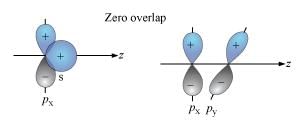
 are bent shape molecule.
are bent shape molecule.
